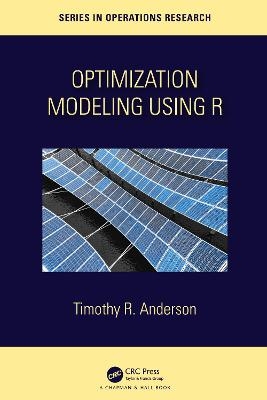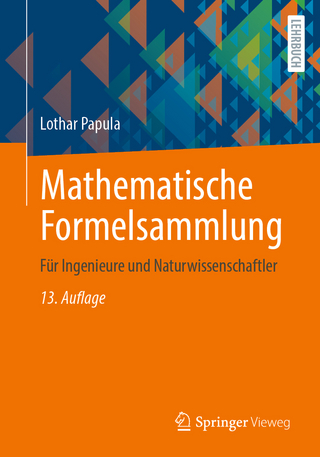
Optimization Modelling Using R
Chapman & Hall/CRC (Verlag)
978-0-367-50789-3 (ISBN)
With the rapid rise of interest in data analytics, a data analytics platform is key. Working technology and business professionals need an awareness of the tools and language of data analysis. R reduces the barrier to entry for people to start using data analytics tools.
Philosophically, the book emphasizes creating formulations before going into
implementation. Algebraic representation allows for clear understanding and generalization
of large applications, and writing formulations is necessary to explain and convey the modeling decisions made.
Appendix A introduces R. Mathematics is used at the level of subscripts and summations Refreshers are provided in Appendix B.
This book:
• Provides and explains code so examples are relatively clear and self-contained.
• Emphasizes creating algebraic formulations before implementing.
• Focuses on application rather than algorithmic details.
• Embodies the philosophy of reproducible research.
• Uses open-source tools to ensure access to powerful optimization tools.
• Promotes open-source: all materials are available on the author’s github repository.
• Demonstrates common debugging practices with a troubleshooting emphasis specific to optimization modeling using R.
• Provides code readers can adapt to their own applications
.
This book can be used for graduate and undergraduate courses for students without a background in optimization and with varying mathematical backgrounds.
Dr. Timothy Anderson is the Department Chair of the Engineering and Technology Management at Portland State University. He earned an Electrical Engineering degree from the University of Minnesota, as well as both M.S. and Ph.D. degrees in Industrial and Systems Engineering from the Georgia Institute of Technology. He leads the Extreme Technology Analytics research group. With over 40 refereed publications, current research interests include analytics, benchmarking, technology forecasting, data mining, and new product development. He is a Sequoyah Fellow of the American Indian Science and Engineering Society. Dr. Anderson is also a past President of Omega Rho, the International Honor Society for Operations Research.
Preface
1 Introduction
1.1 What is Operations Research
1.2 Purpose of this Book
1.3 Range of Operations Research Techniques
1.4 Relationship between Operations Research and Analytics
1.5 Importance of Optimization
1.6 Why R?
1.7 Conventions Used in this Book
2 Introduction to Linear Programming
2.1 What is Linear Programming
2.2 Two Variable Base Case
2.3 Graphically Solving a Linear Program
2.4 Implementing and Solving with ompr
2.4.1 Preparing to Implement the Linear Program
2.4.2 Implementing the Base Case with Piping
2.5 Adding a Third Product (Variable)
2.5.1 Three Variable Base Case Formulation
2.5.2 Three Variable Base Case Implementation
2.5.3 Three Variable Case Results and Interpretation
2.6 Linear Programming Special Cases
2.6.1 Case 1: No Feasible Solution
2.6.2 Case 2: Multiple Optima
2.6.3 Case 3: Redundant Constraint
2.6.4 Case 4: Unbounded Solution
2.7 Abstracting the Production Planning Model
2.8 Methods of Solving Linear Programs
2.9 Exercises
3 More Linear Programming Models
3.1 Types of LP Models
3.2 The Algebraic Model
3.2.1 Tips and Conventions for Algebraic Models
3.2.2 Building the Generalized Model in R
3.2.3 Examining the Results
3.2.4 Changing the Model
3.3 Common Linear Programming Applications
3.3.1 Blending Problems
3.4 Allocation Models
3.4.1 Covering Models
3.4.2 Transportation Models
3.4.3 Transshipment Models
3.4.4 Production and Inventory Planning
3.4.5 Standard Form
3.5 Vector and Matrix Forms of LPs
3.6 Exercises
4 Sensitivity Analysis
4.1 Base Case
4.2 Shadow Prices
4.2.1 Extraction and Interpretation .
4.2.2 Example of Adding an Hour to Assembly
4.2.3 Shadow Prices of Underutilized Resources
4.3 Reduced Costs of Variables
4.3.1 Reduced Cost of Ants
4.3.2 Reduced Price of Bats
4.4 Using Sensitivity Analysis to Evaluate a New Product
4.5 Exercises
5 Data Envelopment Analysis
5.1 Introduction
5.2 Creating the Data
5.3 Graphical Analysis
5.4 The Linear Programs for DEA
5.4.1 An Explicit Linear Program for DEA
5.4.2 A Generalized Linear Program for DEA
5.5 Creating the LP - The Algebraic Approach
5.6 Returns to Scale
5.7 Multiple Inputs and Multiple Outputs
5.8 Extracting Multiplier Weights from Sensitivity Analysis
5.9 Slack Maximization
5.10 DEA Packages
5.11 DEA Model Building
5.11.1 Selection of Inputs and Outputs
5.11.2 Model Choices
5.11.3 Application Area Expertise
5.12 Further Reading
5.13 Exercises
6 Mixed Integer Optimization
6.1 Example of Minor Integrality Impact
6.2 Example of Major Integality Impact
6.3 The Branch and Bound Algorithm
6.3.1 The LP Relaxation
6.3.2 Subproblem I
6.3.3 Subproblem III
6.3.4 Subproblem IV
6.3.5 Subproblem V
6.3.6 Subproblem VI
6.3.7 Subproblem VII
6.3.8 Subproblem VIII
6.3.9 Subproblem II
6.4 Computational Complexity
6.4.1 Full Enumeration
6.5 Binary Variables and Logical Relations
6.6 Fixed Charge Models
6.6.1 Fixed Charge Example-Introduction
6.6.2 Linking Constraints with “Big M”
6.6.3 Fixed Charge Implementation
6.7 Model Results and Interpretation
7 More Integer Programming Models
7.1 Overview
7.2 Revisiting the Warehouse Location Problem
7.2.1 Implementing the Warehouse Model
7.2.2 Solving the Warehouse Location Problem
7.2.3 Warehouse Discussion
7.3 Solving MIPs with Different Solvers
7.3.1 Performance of glpk
7.3.2 Performance of symphony
7.3.3 Performance of lpsolve
7.3.4 Performance of gurobi
7.3.5 Comparing Results across Solvers
7.3.6 Popularity of LP Solvers
7.4 Solving Sudoku Puzzles using Optimization
7.4.1 Introduction to Sudoku and Optimization
7.4.2 Formulating the Sudoku Problem
7.4.3 Implementing Sudoku in ompr
7.4.4 Sudoku Discussion
7.5 Exercises
7.6 Production Planning over Time
7.6.1 Implementing the Model
7.7 Additional Exercises
8 Goal Programming
8.1 Introduction
8.2 Preemptive Goal Programming
8.3 Policies for Houselessness
8.4 Mass Mailings
8.4.1 Formulating the State Mailing Model
8.4.2 Implementing the State Mailing Model
8.4.3 Frontloading the Work
8.5 Exercises
Appendix
A A Very Brief Introduction to R
A.1 Purpose
A.2 Getting Started with R
A.3 Exercises
B Introduction to Math Notation
B.1 Purpose
B.2 Basic Summation Notation
B.3 Using LaTeX in RMarkdown
B.4 Inline Notation
B.5 Sums
B.6 Delimiters
B.7 Summary of Mathematical Notations
B.8 Sequences and Summation Notation
B.9 Applications of Summation
B.10 Double Summation
B.11 Applications of Double Summation
B.12 Exercises
C Troubleshooting
C.1 Overview
C.2 Model Building
C.2.1 Define and Formulate before Implementing
C.2.2 Failing to Look for Past Optimization Models
C.2.3 Misrendering of PDF
C.2.4 Blank Lines in LaTeX
C.2.5 Problems with PDF Creation
C.3 Implementation Troubleshooting
C.3.1 Errors in a Piped Model
C.3.2 Undefined Object in ompr
C.3.3 Unexpected Symbol in ompr
C.3.4 Name Conflicts between R and ompr
C.3.5 Blindly Reusing Code
C.4 General Debugging Tips
C.5 Getting Help
D Making Good Tables 263
D.1 Importance of Tables in Modeling
D.2 Kable vs. Kbl
D.3 Table Footnotes with Kable
D.4 Setting Row and Column Names in Kable
D.5 Booktabs vs. Default
D.6 Using LaTeX in Kable Column Names
D.7 Fitting Tables to Page Width
Bibliography
Index
| Erscheinungsdatum | 16.06.2022 |
|---|---|
| Reihe/Serie | Chapman & Hall/CRC Series in Operations Research |
| Zusatzinfo | 117 Tables, black and white; 41 Line drawings, black and white; 41 Illustrations, black and white |
| Sprache | englisch |
| Maße | 156 x 234 mm |
| Gewicht | 571 g |
| Themenwelt | Mathematik / Informatik ► Mathematik ► Angewandte Mathematik |
| Mathematik / Informatik ► Mathematik ► Computerprogramme / Computeralgebra | |
| Mathematik / Informatik ► Mathematik ► Finanz- / Wirtschaftsmathematik | |
| Technik ► Umwelttechnik / Biotechnologie | |
| ISBN-10 | 0-367-50789-7 / 0367507897 |
| ISBN-13 | 978-0-367-50789-3 / 9780367507893 |
| Zustand | Neuware |
| Informationen gemäß Produktsicherheitsverordnung (GPSR) | |
| Haben Sie eine Frage zum Produkt? |
aus dem Bereich


